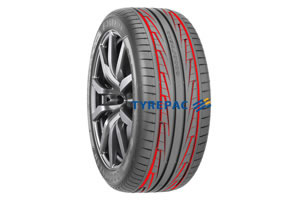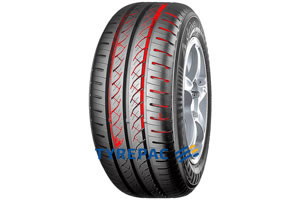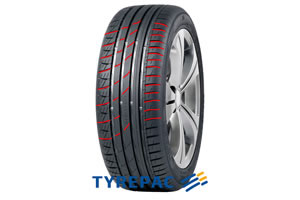Car tyres - Understand the different designs
07 Mar 2012|40,522 views
We estimate that at least 80% of tyre buyers do not know that the design of a tyre have differing characteristics. And quite often, this results in unhappiness with a set of tyre purchased.
Before embarking on purchasing a set of tyres, it is important to first know your driving style, and the preferred characteristics delivered by them. The two key factors which are the relevant to most motorists are water and noise. Water because it affects your breaking distance, especially in Singapore's weather conditions. Noise because it can be quite unbearable to have your tyre humming and drumming throughout your ride. In the rest of this article, the focus will revolve around these two factors.
There is unfortunately a reverse relationship between a quiet tyre and a wet performance tyre - meaning to say, a quiet tyre is rarely excellent in the wet, and a wet performing tyre is rarely quiet (for ride comfort). Understanding tyre design should therefore help in deciding what is best for you.
Tyre designs can be broadly categorised under Directional design, Symmetrical (wave) design and Asymmetrical design.
Directional design
Tyres designed with grooves in a directional manner disperse water in the most economical manner. Outwards and away from the direction of travel to give you better road holding during wet weather. And the wider the grooves, the better it is with water-dispersion. However, wider grooves (particularly arranged in a directional manner) also generates the most road noise, since grooves are arranged against the direction of travel. And the wider grooves for better water dispersion results in air trapped, compressed, and released continuously - which creates "tyre noise".
Before embarking on purchasing a set of tyres, it is important to first know your driving style, and the preferred characteristics delivered by them. The two key factors which are the relevant to most motorists are water and noise. Water because it affects your breaking distance, especially in Singapore's weather conditions. Noise because it can be quite unbearable to have your tyre humming and drumming throughout your ride. In the rest of this article, the focus will revolve around these two factors.
There is unfortunately a reverse relationship between a quiet tyre and a wet performance tyre - meaning to say, a quiet tyre is rarely excellent in the wet, and a wet performing tyre is rarely quiet (for ride comfort). Understanding tyre design should therefore help in deciding what is best for you.
Tyre designs can be broadly categorised under Directional design, Symmetrical (wave) design and Asymmetrical design.
Directional design
Tyres designed with grooves in a directional manner disperse water in the most economical manner. Outwards and away from the direction of travel to give you better road holding during wet weather. And the wider the grooves, the better it is with water-dispersion. However, wider grooves (particularly arranged in a directional manner) also generates the most road noise, since grooves are arranged against the direction of travel. And the wider grooves for better water dispersion results in air trapped, compressed, and released continuously - which creates "tyre noise".
 |
Directional tyre designs will cater to consumers who can tolerate some level of tyre noise, and have preference for wet performance over riding comfort.
There are exceptions whereby directional tyres are designed more for comfort than wet performance. The way to judge would be to see how aggressive or how wide the grooves are.
Symmetrical design/ wave/ non-directional design
Symmetrical designed tyres have grooves arranged in a wave like manner, and usually have smaller lateral grooves cutting the tyre design, to further break up road noise.
Tyre designs such as these are usually quieter since priority is not in wet weather performance, but rather providing a quiet ride. There are again exceptions, when wider grooves are built-in to cater to slightly better wet weather performance.
Asymmetric design
Asymmetric designed tyres are a combination of comfort and wet weather performance- combining the principles of wet-weather, and principles of comfort. Half the surface of the tyre tread is designed for wet performance, while the other half is for comfort.
Asymmetric designed tyres have gradually grown in popularity in recent years, and are now readily available, but usually with a small premium in price.
So the next time you need a set of tyres, read into the tyre design and decide what is best for you. Happy motoring!
There are exceptions whereby directional tyres are designed more for comfort than wet performance. The way to judge would be to see how aggressive or how wide the grooves are.
Symmetrical design/ wave/ non-directional design
Symmetrical designed tyres have grooves arranged in a wave like manner, and usually have smaller lateral grooves cutting the tyre design, to further break up road noise.
 |
Tyre designs such as these are usually quieter since priority is not in wet weather performance, but rather providing a quiet ride. There are again exceptions, when wider grooves are built-in to cater to slightly better wet weather performance.
Asymmetric design
Asymmetric designed tyres are a combination of comfort and wet weather performance- combining the principles of wet-weather, and principles of comfort. Half the surface of the tyre tread is designed for wet performance, while the other half is for comfort.
 |
Asymmetric designed tyres have gradually grown in popularity in recent years, and are now readily available, but usually with a small premium in price.
So the next time you need a set of tyres, read into the tyre design and decide what is best for you. Happy motoring!
We estimate that at least 80% of tyre buyers do not know that the design of a tyre have differing characteristics. And quite often, this results in unhappiness with a set of tyre purchased.
Before embarking on purchasing a set of tyres, it is important to first know your driving style, and the preferred characteristics delivered by them. The two key factors which are the relevant to most motorists are water and noise. Water because it affects your breaking distance, especially in Singapore's weather conditions. Noise because it can be quite unbearable to have your tyre humming and drumming throughout your ride. In the rest of this article, the focus will revolve around these two factors.
There is unfortunately a reverse relationship between a quiet tyre and a wet performance tyre - meaning to say, a quiet tyre is rarely excellent in the wet, and a wet performing tyre is rarely quiet (for ride comfort). Understanding tyre design should therefore help in deciding what is best for you.
Tyre designs can be broadly categorised under Directional design, Symmetrical (wave) design and Asymmetrical design.
Directional design
Tyres designed with grooves in a directional manner disperse water in the most economical manner. Outwards and away from the direction of travel to give you better road holding during wet weather. And the wider the grooves, the better it is with water-dispersion. However, wider grooves (particularly arranged in a directional manner) also generates the most road noise, since grooves are arranged against the direction of travel. And the wider grooves for better water dispersion results in air trapped, compressed, and released continuously - which creates "tyre noise".
Before embarking on purchasing a set of tyres, it is important to first know your driving style, and the preferred characteristics delivered by them. The two key factors which are the relevant to most motorists are water and noise. Water because it affects your breaking distance, especially in Singapore's weather conditions. Noise because it can be quite unbearable to have your tyre humming and drumming throughout your ride. In the rest of this article, the focus will revolve around these two factors.
There is unfortunately a reverse relationship between a quiet tyre and a wet performance tyre - meaning to say, a quiet tyre is rarely excellent in the wet, and a wet performing tyre is rarely quiet (for ride comfort). Understanding tyre design should therefore help in deciding what is best for you.
Tyre designs can be broadly categorised under Directional design, Symmetrical (wave) design and Asymmetrical design.
Directional design
Tyres designed with grooves in a directional manner disperse water in the most economical manner. Outwards and away from the direction of travel to give you better road holding during wet weather. And the wider the grooves, the better it is with water-dispersion. However, wider grooves (particularly arranged in a directional manner) also generates the most road noise, since grooves are arranged against the direction of travel. And the wider grooves for better water dispersion results in air trapped, compressed, and released continuously - which creates "tyre noise".
 |
Directional tyre designs will cater to consumers who can tolerate some level of tyre noise, and have preference for wet performance over riding comfort.
There are exceptions whereby directional tyres are designed more for comfort than wet performance. The way to judge would be to see how aggressive or how wide the grooves are.
Symmetrical design/ wave/ non-directional design
Symmetrical designed tyres have grooves arranged in a wave like manner, and usually have smaller lateral grooves cutting the tyre design, to further break up road noise.
Tyre designs such as these are usually quieter since priority is not in wet weather performance, but rather providing a quiet ride. There are again exceptions, when wider grooves are built-in to cater to slightly better wet weather performance.
Asymmetric design
Asymmetric designed tyres are a combination of comfort and wet weather performance- combining the principles of wet-weather, and principles of comfort. Half the surface of the tyre tread is designed for wet performance, while the other half is for comfort.
Asymmetric designed tyres have gradually grown in popularity in recent years, and are now readily available, but usually with a small premium in price.
So the next time you need a set of tyres, read into the tyre design and decide what is best for you. Happy motoring!
There are exceptions whereby directional tyres are designed more for comfort than wet performance. The way to judge would be to see how aggressive or how wide the grooves are.
Symmetrical design/ wave/ non-directional design
Symmetrical designed tyres have grooves arranged in a wave like manner, and usually have smaller lateral grooves cutting the tyre design, to further break up road noise.
 |
Tyre designs such as these are usually quieter since priority is not in wet weather performance, but rather providing a quiet ride. There are again exceptions, when wider grooves are built-in to cater to slightly better wet weather performance.
Asymmetric design
Asymmetric designed tyres are a combination of comfort and wet weather performance- combining the principles of wet-weather, and principles of comfort. Half the surface of the tyre tread is designed for wet performance, while the other half is for comfort.
 |
Asymmetric designed tyres have gradually grown in popularity in recent years, and are now readily available, but usually with a small premium in price.
So the next time you need a set of tyres, read into the tyre design and decide what is best for you. Happy motoring!













